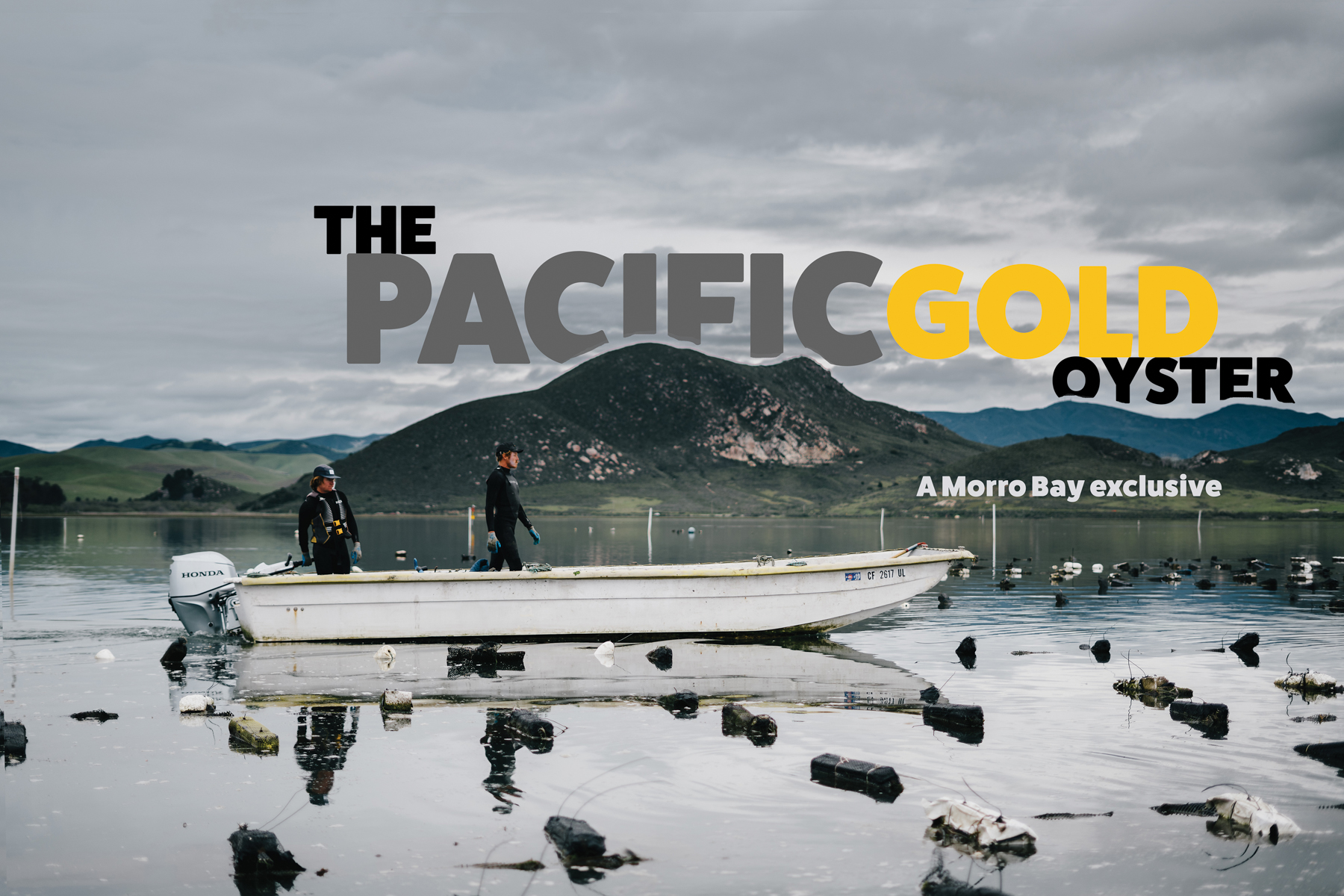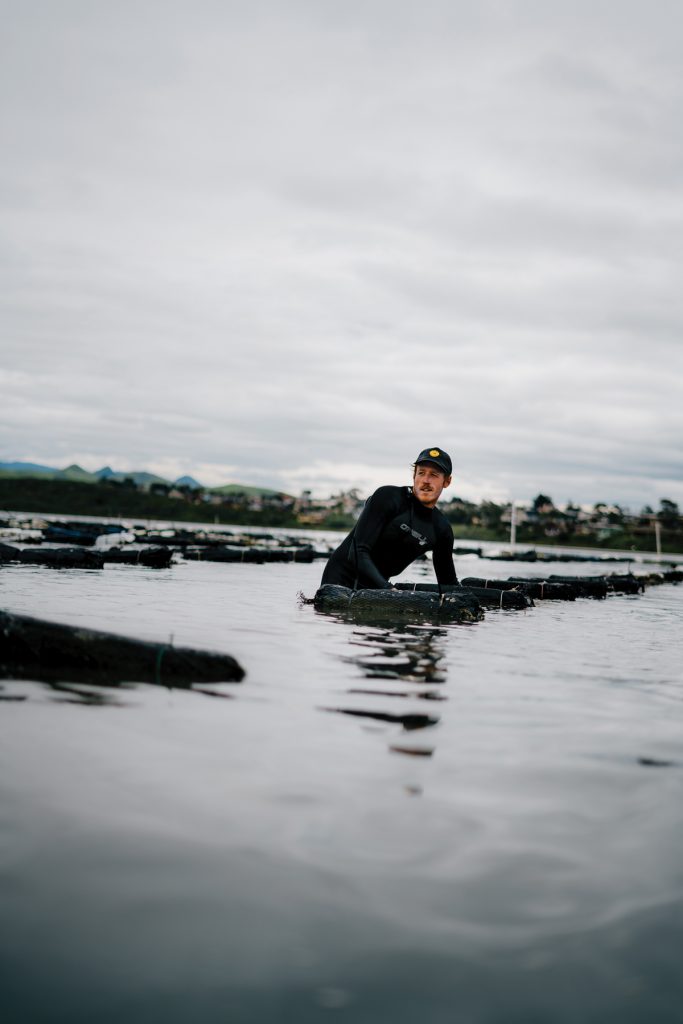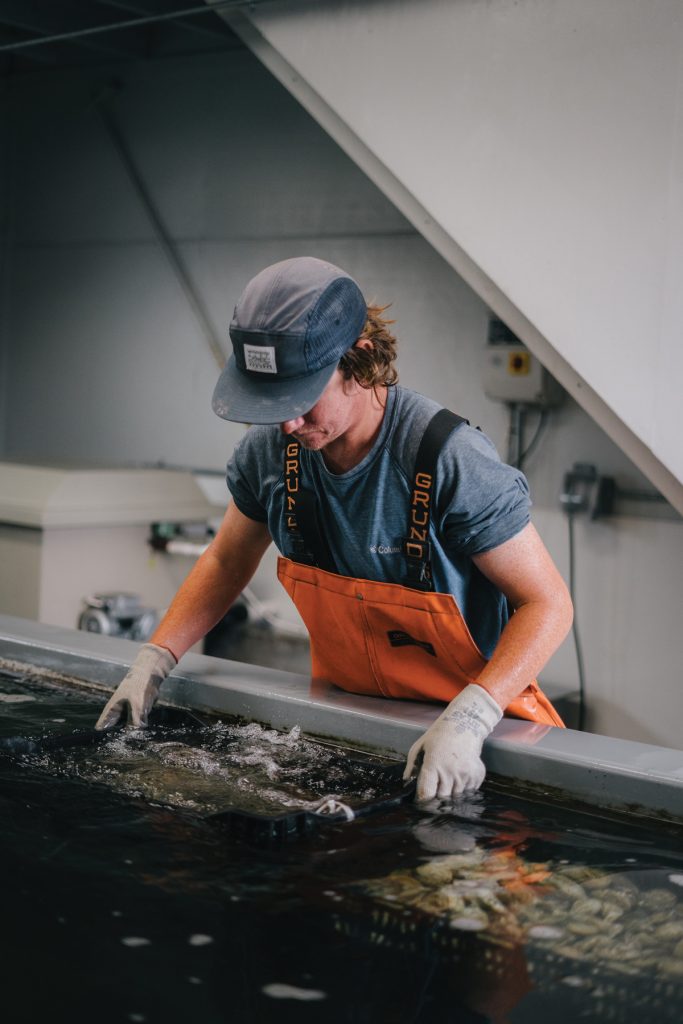
The Pacific Gold Oyster
Photos by Nash Moreno
Farming for Morro Bay-exclusive oysters.
Morro Rock is a prominent physical presence, and a peregrine Falcon preserve, found at the entrance to Morro Bay. It is a volcanic plug located within the Morro Bay National Estuary. Water flows through volcanic aquifers from Chorro Creek and Los Osos Creek. It’s here, where the contrasting environments meet, that Morro Bay Oyster Company lovingly labors over their Pacific Gold oysters.
Pacific Gold oysters are a hardy species of oyster that thrive in the cold, rich waters of Morro Bay, and are found only in Morro Bay.Streams that lead into a bay or area suitable for oyster farming are very limited, so there are very few oyster farms, approximately 15 of them at last official count, found on the West Coast. The convergence of elements from the volcanic aquifers and tides brings constant changes in salinity, temperature and nutrients, yet the Pacific Gold oyster adapts to these changes over the course of its life and develops a robust flavor because of it. When coastal storms bring rain and the salinity drops in the oyster beds, the Pacific Gold oyster will develop a distinct melon finish. The strong northwest winds of spring cause the upwelling of cold, salty, nutrient rich water that is found deep near the ocean floor. The strong tides bring this water into the farm twice a day, which allows the oysters to explode with growth and take on hints of the fresh salty brine that surrounds them.
Foam buoys sway with the waves. They thump and squeak as they gently bump and nudge each other or grasp the edges of the dock. We make our way past these, and by Morro Rock, with waves gently slapping the bottom of the flat-bottomed oyster boat. Suddenly surrounded by row upon row of floating oyster beds, what become apparent are the striking similarities and stark differences between traditional farming and oyster farming, a form of aquaculture.
“People don’t necessarily understand oyster ‘farming.’ Very few people get that we’re growing oysters. We are farmers. We have rows of straight crops. We plant seed. We harvest our product. Aquaculture is farming in the ocean,” says company Founder Neal Maloney, an ever-faithful student of marine life, having earned his degree from the University of Oregon where he studied Marine Biology and Business. Neal then continued on, studying Invertebrate Zoology and Marine Ecology at the Oregon Institute of Marine Biology in Coos Bay as well as specialized studies in Aquaculture and Conservation at Instituto Tecnológico y de Estudios Superiores de Monterrey — Guaymas México. Morro Bay Oyster Company was born in 2008, under Neal’s leadership, with a focus on the Pacific Gold oyster.

The rows of oysters are submerged and buoyed, lined up like crops in a field. Both traditional farmers and oyster farmers constantly battle the weather, and adjust to changes in the local environment. Oyster farmers have the added challenge of dealing with waves, tides and the occasional supermoon, which tug at the tides and constantly change the oyster environment.
To draw along parallels even further, horticulture and aquaculture work requires being exposed to the elements for hours each day. Love for the outdoors is essential to maintain longevity in either type of work. Being surrounded by nature all but promises unintentional interactions with critters, with a layer of excitement added to oyster farmers who must often reach below the water and grab without being able to see what they are about to touch.
Traditional farming produces environmental waste, while oysters are a “crop” that not only absorbs carbon but then turns it into calcium carbonate to strengthen and grow their shells. They also absorb nitrogen, a greenhouse gas, during the time it takes for them to reach 4-inch market size. This exchange happens as a single oyster filters up to 50 gallons of water each day, improving the environment around them as they grow.
One might be tempted to think the hard work at Morro Bay Oyster Company is over once the daily harvest is picked and delivered to shore, when, actually, maintaining the business out of the water is equally as challenging. When Morro Bay Oyster Company opened over 10 years ago, there was no built-in market for offloading the nearly 750,000 oysters being harvested annually. Some would buy directly from the company on the weekends, but it was when the team created relationships with chefs and buyers throughout California that they maintained success. “I was sold this production farm when I was 25 years old, very naïve,” says Neal. “I was hustling oysters on the docks, off the side of the road, at farmers’ markets, swap meets. It wasn’t until chefs came and bought up my whole crop that I realized this is the future of the company — this is where the business can grow.”

Because of Morro Bay Oyster Company, the Pacific Gold oyster is harvested and delivered to local chefs and restaurants on the Embarcadero, and also distributed through Santa Monica Seafood to establishments beyond the local radius. The buyers are then rewarded with a delivery of fresh oysters at their peak, always moved using one-day delivery. Harvesting a product freshly and delivering it before anyone else can is how Neal developed Morro Bay Oyster Company, still doing so today, shipping fresh product all over the United States.
It’s a unique job,” Neal continues. “Customer gets an oyster and they see just the animal on the plate. Perhaps they don’t know the backstory, what it took to get that oyster on their plate. Oysters grow in harsh environments, have a high mortality. The first year this farm got started, we planted 3 million oysters and a red tide came through that they hadn’t seen in a decade. It sucked the oxygen out of the water and killed 97% of them. That was a really tough start.”
It is a nearly 16-month sustainable aquaculture process of getting this treasure onto the plate for consumption. These locally grown Pacific Gold oysters, with their briny, buttery flavor, are harvested year-round, so the flavor profile changes slightly throughout the year as they succumb to seasonal environmental changes. Between the oysters’ flavor intricacies and the harvesting process, Pacific Gold oysters are truly something to be appreciated — a Central Coast delicacy.

